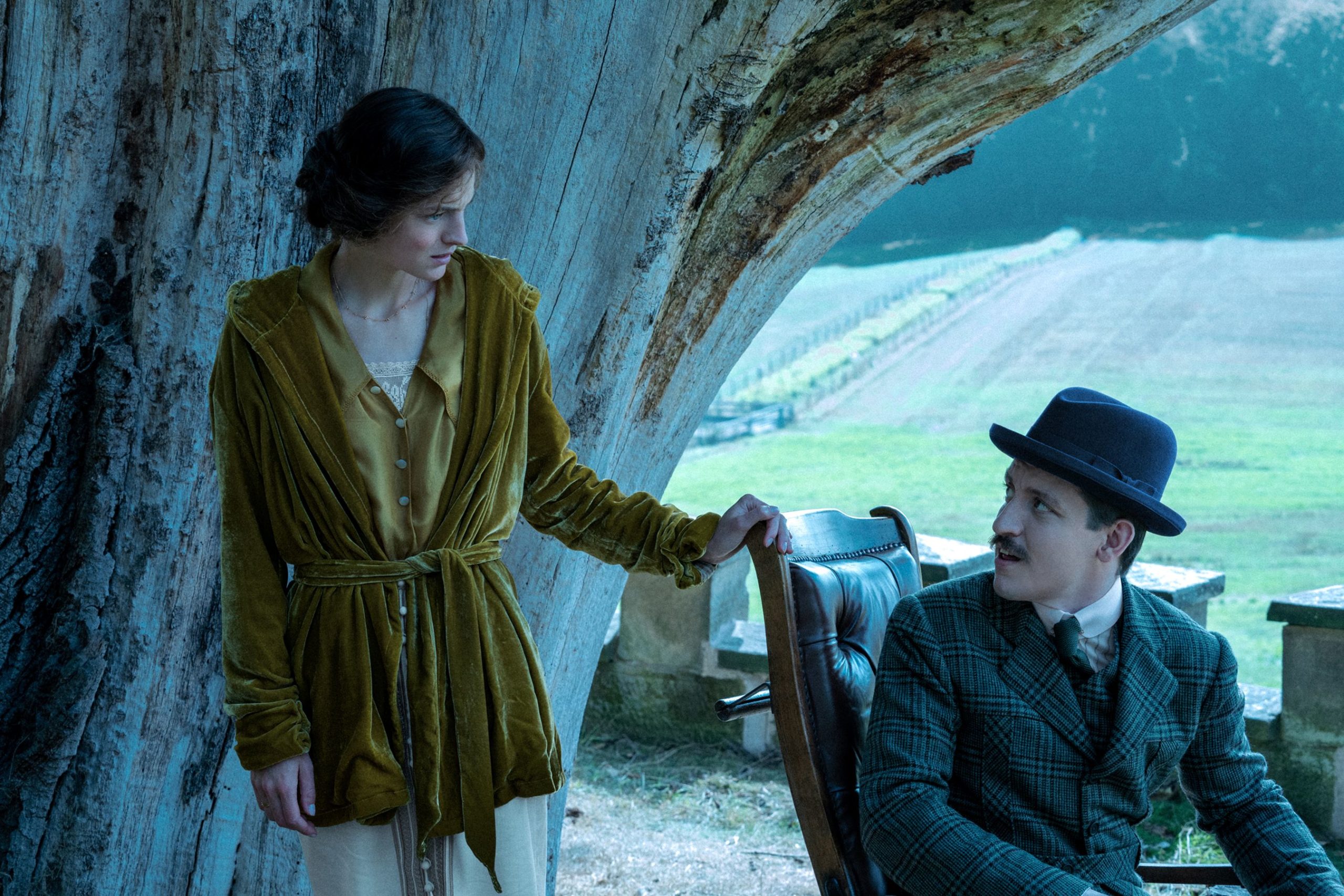Warning: Spoilers ahead. Strong sexual content, graphic nudity, and some language.
The ad for Lady Chatterley’s Lover (2022) on Netflix first captured my attention with Emma Corrin’s striking features. It came as no surprise that, like the other Emma – Emma D’Arcy, Corrin are part of the growing cohort of otherworldly-looking, wildly talented British actors who use they/them pronouns. The French-born director Laure de Clermont-Tonnerre’s strategic choice to entrust the interpretation of a conventional, feminine character to a non-binary actor pays off: Corrin’s Lady Chatterley is awkward, edgy, and uninhibited at the same time.

She brings modernity to a classic tale of an upper-class woman falling in love beneath her station, by taking Connie Chatterley out of Stepford Wives’ town and into the social non-conformist territory. Sometimes, with mixed results: the word “bullying” that Connie employs to summarize her lord husband’s exploitation of mine workers, belongs more in the vocabulary of a social justice warrior than in an early 20th-century revolutionary talk. The film spells it clearly that Connie’s background is Bohemian. Which supposedly gives her the right to look down on her husband’s land-based wealth, while her own three-month vacay in Venice comes guilt-free, paid by her father’s art endeavors.
Since its publication in 1928, the last novel by English author D. H. Lawrence has been committed to screen countless times. The story traveled as far as Japan (Lady Chatterley of Japan, 1953 and Lady Chatterley in Tokyo, 1977) and the Czech Republic (Milenec lady Chatterleyové, 1998 ). There was even Lady Chatterley’s Revenge, 1957, and gender-revealing Lady Chatterley’s Daughter, 2011. The last global blockbuster, starring ‘70s wild child Sylvia Kristel, dates back to 1981. So, what does the new Lady Chatterley’s Lover have to offer?
For one, we finally get equal treatment of all naked bodies on screen! In a scene that is reminiscent of the Garden of Eden, both Lady Chatterley and her lover go full-frontal frolicking under the sun shower. But the principal merit of this latest update seems to reside in its impeccable execution. Shot in cold tones, atmospheric, and understated, it is a cool revisitation of the controversial masterpiece, packaged for millennials.
As in the best book-to-screen adaptations of British authors, everything is in a dialogue, where every line is a perfectly crafted missive of subtext, character reflection, and intent. Paralyzed from the waist down, Baronet Clifford Chatterley is polite and all, but he lords over his estate and wife with refinement and gusto. When Constance asks to go to London for a much-needed breather, Clifford doesn’t forbid it. That would be in poor taste. Instead, he suggests inviting her sister to the estate. “At least, she can come.” In the book, Clifford’s arc is defined by being maimed during the war, family expectations, aging, and the need to run a vast estate. All of these make him degrade, gain weight, and become a person who Connie finds utterly unattractive. But as soon as the director and screenwriter depart from the novel, the character’s authenticity takes a major hit: Matthew Duckett’s Lord Chatterley descends into a cartoonish, one-dimensional villain reduced to spouting nonsense about being brought up to rule over peasants. By basking in Sir Clifford’s emotional immaturity and, sometimes, plain stupidity, director Laure de Clermont-Tonnerre seems to expiate demons of her own aristocratic background.

Jack O’Connell’s depiction of Mellors, Lady Chatterley’s lover himself, is surprisingly nuanced, controlled, and mature. At times, it feels as if the careful construction of Mellors as a full-fledged character and someone with a pulse, happened almost in secret from the rest of the production. The lady’s lover was meant to be an athletically built diamond-in-the-rough with amazing lovemaking skills. Instead, O’Connell delivers us a quaint war veteran, a man in the midst of a bitter divorce, extremely careful about who he lets close to him. Mellors’ decency and layered vulnerability are so endearing that at some point, I got scared that he would end up as a discarded plaything. Turns out, the fears were shared. “So, you made use of me?” Mellors asks upon learning that Connie is pregnant. Although on the surface, his reaction seems ‘toxic’, it shows that the perspective of watching his child being pampered and primed by Sir Clifford to become the next Lord Chatterley, pains Mellors more than he thought it would. Similarly, Mellors’s dismissal from the estate, by Sir Clifford, albeit laconic and seemingly detached, is very telling of both men and the balance of power between them.
The all-white support cast delivers equally solid performances. The Lady Chatterley’s Lover is inclusive of all gender perspectives; the novel was written by a 20th-century man about the sexual emancipation of a woman, the film was directed by a female director, with the title characters interpreted by a non-binary Corrin and a manly man Jack O’Connell. All of which makes for a fascinating and pleasant watch that I highly recommend.

Comments